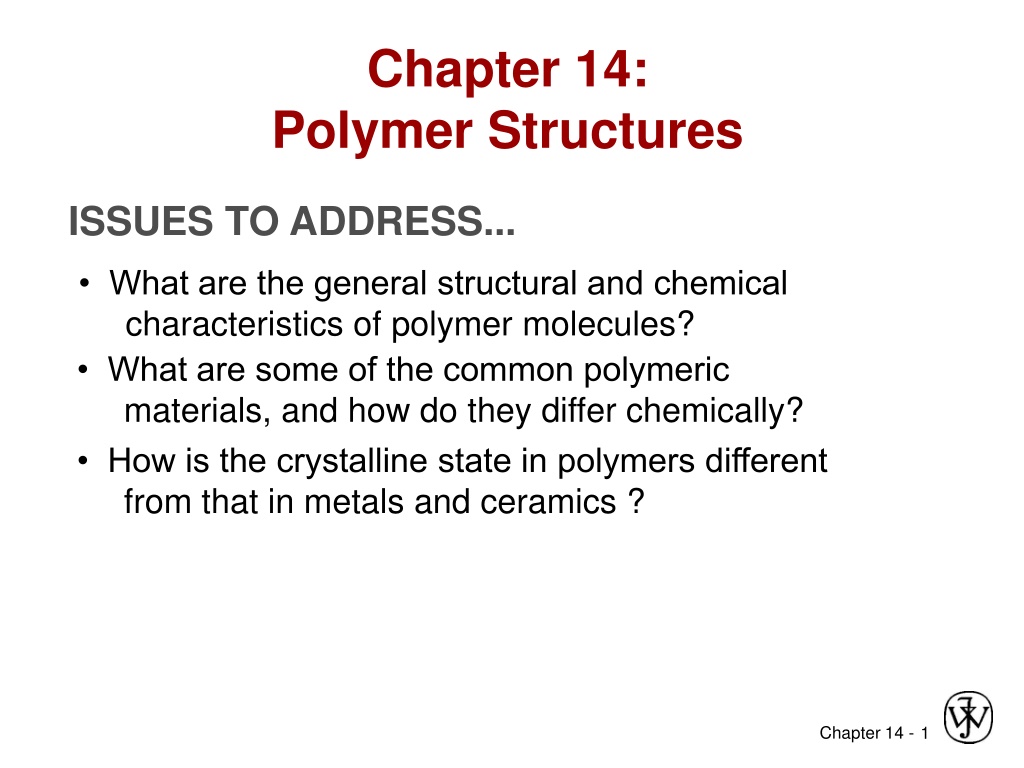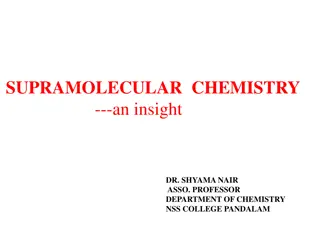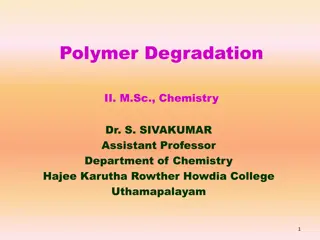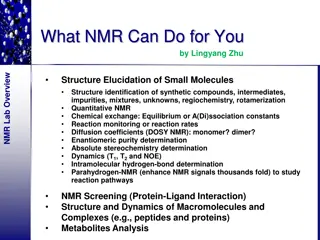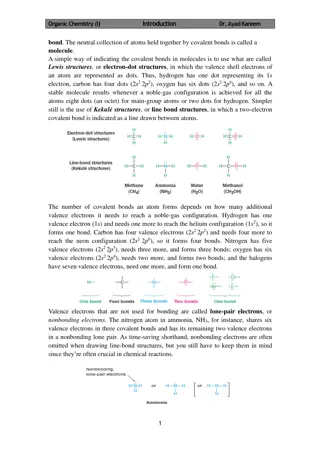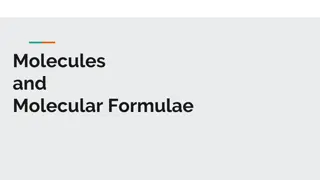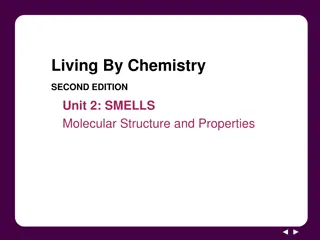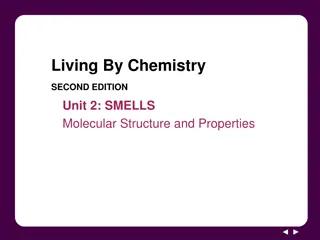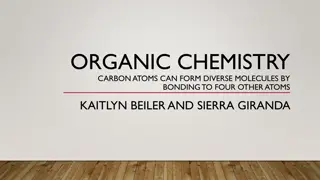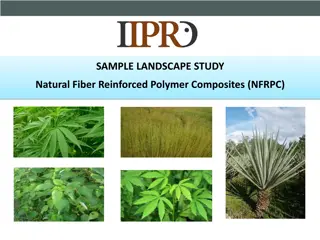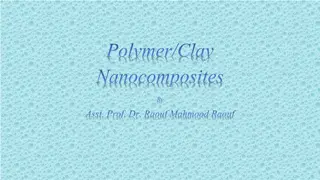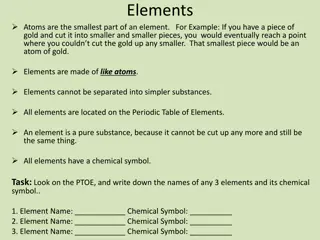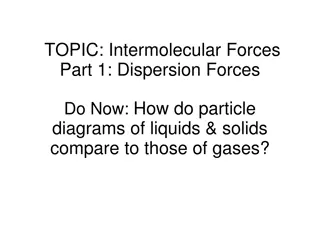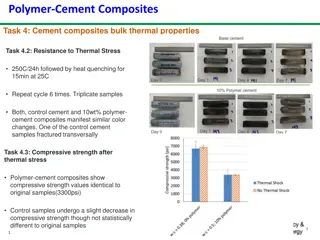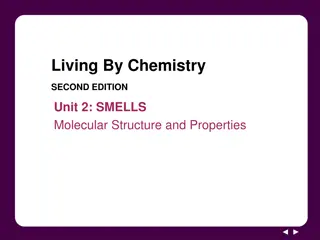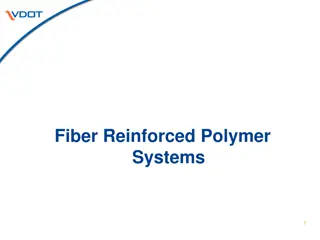Polymer Molecules: Structure and Chemistry
Discover the structural and chemical characteristics of polymer molecules, common polymeric materials, and the differences in crystalline states compared to metals and ceramics. From ancient natural polymers to modern polymerization processes, explore the composition and isomerism of polymers in this insightful chapter.
Download Presentation

Please find below an Image/Link to download the presentation.
The content on the website is provided AS IS for your information and personal use only. It may not be sold, licensed, or shared on other websites without obtaining consent from the author.If you encounter any issues during the download, it is possible that the publisher has removed the file from their server.
You are allowed to download the files provided on this website for personal or commercial use, subject to the condition that they are used lawfully. All files are the property of their respective owners.
The content on the website is provided AS IS for your information and personal use only. It may not be sold, licensed, or shared on other websites without obtaining consent from the author.
E N D
Presentation Transcript
Chapter 14: Polymer Structures ISSUES TO ADDRESS... What are the general structural and chemical characteristics of polymer molecules? What are some of the common polymeric materials, and how do they differ chemically? How is the crystalline state in polymers different from that in metals and ceramics ? Chapter 14 - 1
What is a Polymer? many repeat unit Poly mer repeat unit repeat unit repeat unit H H H H H H H H H H H H H C H C CH3H H H H C H C CH3 C C C C C C H H H Polyethylene (PE) C C C C C C H H Poly(vinyl chloride) (PVC) C C CH3 H H H H H H Cl Cl Cl Polypropylene (PP) Adapted from Fig. 14.2, Callister & Rethwisch 8e. Chapter 14 - 2
Ancient Polymers Originally natural polymers were used Wood Cotton Leather Rubber Wool Silk Oldest known uses Rubber balls used by Incas Noah used pitch (a natural polymer) for the ark Chapter 14 - 3
Polymer Composition Most polymers are hydrocarbons i.e., made up of H and C Saturated hydrocarbons Each carbon singly bonded to four other atoms Example: Ethane, C2H6 H H H C C HH H Chapter 14 - 4
Unsaturated Hydrocarbons Double & triple bonds somewhat unstable can form new bonds Double bond found in ethylene or ethene - C2H4 H H C C H H Triple bond found in acetylene or ethyne - C2H2 H C C H Chapter 14 - 6
Isomerism Isomerism two compounds with same chemical formula can have quite different structures for example: C8H18 normal-octane H H H H H H H H = H C C C C C C C C H H H H H H3C CH2CH2CH2CH2CH2CH2CH3 H H H H H3C CH2 ( CH3 )6 2,4-dimethylhexane CH3 H3C CH CH2CH CH3 CH2 CH3 Chapter 14 - 7
Polymerization and Polymer Chemistry Free radical polymerization H R + H H H initiation C H C H R C H C H free radical monomer (ethylene) H H H H H H H H + propagation R C H C H C H C H R C H C H C H C H dimer Initiator: example - benzoyl peroxide H H H C H O = 2 R C H O O C 2 H Chapter 14 - 8
Chemistry and Structure of Polyethylene Adapted from Fig. 14.1, Callister & Rethwisch 8e. Note: polyethylene is a long-chain hydrocarbon - paraffin wax for candles is short polyethylene Chapter 14 - 9
Bulk or Commodity Polymers Chapter 14 -10
Bulk or Commodity Polymers (cont) Chapter 14 -11
Bulk or Commodity Polymers (cont) Chapter 14 -12
VMSE: Polymer Repeat Unit Structures Manipulate and rotate polymer structures in 3-dimensions Chapter 14 - 13
MOLECULAR WEIGHT Molecular weight, M: Mass of a mole of chains. Low M high M Not all chains in a polymer are of the same length i.e., there is a distribution of molecular weights Chapter 14 -14
MOLECULAR WEIGHT DISTRIBUTION Adapted from Fig. 14.4, Callister & Rethwisch 8e. total wt of polymer = M n total # of molecules Mn = xiMi Mw = wiMi Mi= mean (middle) molecular weight of size range i xi= number fraction of chains in size range i wi= weight fraction of chains in size range i Chapter 14 -15
Molecular Weight Calculation Example: average mass of a class Student Weight mass (lb) 104 116 140 143 180 182 191 220 225 380 What is the average weight of the students in this class: a) Based on the number fraction of students in each mass range? b) Based on the weight fraction of students in each mass range? 1 2 3 4 5 6 7 8 9 10 Chapter 14 -16
Molecular Weight Calculation (cont.) Solution: The first step is to sort the students into weight ranges. Using 40 lb ranges gives the following table: weight range number of students Ni mean weight Wi mass (lb) 110 142 184 223 - - - 380 number fraction xi weight fraction wi Ni Ni Calculate the number and weight fraction of students in each weight range as follows: NiWi NiWi mass (lb) 81-120 121-160 161-200 201-240 241-280 281-320 321-360 361-400 wi= xi= 2 2 3 2 0 0 0 1 0.2 0.2 0.3 0.2 0 0 0 0.1 0.117 0.150 0.294 0.237 0.000 0.000 0.000 0.202 120 For example: for the 81-120 lb range x81 120=2 10= 0.2 x 2 81 = w 1 1 0 = . 0 117 1881 Ni 10 NiWi 1881 total weight total number Chapter 14 -17
Molecular Weight Calculation (cont.) weight range mean weight Wi mass (lb) 110 142 184 223 - - - 380 number fraction xi weight fraction wi mass (lb) 81-120 121-160 161-200 201-240 241-280 281-320 321-360 361-400 0.2 0.2 0.3 0.2 0 0 0 0.1 0.117 0.150 0.294 0.237 0.000 0.000 0.000 0.202 Mn = = (0.2 x 110+0.2 x 142+0.3 x 184+0.2 x 223+0.1 x 380) =188 lb xiMi Mw = = (0.117 x 110+0.150 x 142+0.294 x 184 wiMi +0.237 x 223+0.202 x 380)= 218 lb Mw = wiMi = 218 lb Chapter 14 -18
Degree of Polymerization, DP DP = average number of repeat units per chain H H H H H H H H H H H H DP = 6 ( ) H C C C C C C C C H H H H C C C C H H H H H H H H H M n = DP m = where m average molecular weight of repeat unit for copolymers calculated is this follows as : = m f im i Chain fraction mol. wt of repeat unit i Chapter 14 -19
Molecular Structures for Polymers secondarybonding Linear Branched Cross-Linked Network Adapted from Fig. 14.7, Callister & Rethwisch 8e. Chapter 14 -20
Polymers Molecular Shape Molecular Shape (or Conformation) chain bending and twisting are possible by rotation of carbon atoms around their chain bonds note: not necessary to break chain bonds to alter molecular shape Adapted from Fig. 14.5, Callister & Rethwisch 8e. Chapter 14 -21
Chain End-to-End Distance, r Adapted from Fig. 14.6, Callister & Rethwisch 8e. Chapter 14 -22
Molecular Configurations for Polymers Configurations to change must break bonds Stereoisomerism H H H R H H C C or C C H C C H H R R H A A Stereoisomers are mirror images can t superimpose without breaking a bond C C E E B B D D mirror plane Chapter 14 -23
Tacticity Tacticity stereoregularity or spatial arrangement of R units along chain isotactic all R groups on same side of chain syndiotactic R groups alternate sides H H H C H C H C H C H C H C H H H R H H H C R C C H C R C H C R C H C H C H C R H R H R H R H H Chapter 14 -24
Tacticity (cont.) atactic R groups randomly positioned H H H C H C H C R C H C H C C H C R H R H H H R Chapter 14 -25
cis/trans Isomerism CH3 H CH3 CH2 C C C C CH2 CH2 CH2 H cis trans cis-isoprene (natural rubber) trans-isoprene (gutta percha) H atom and CH3 group on same side of chain H atom and CH3 group on opposite sides of chain Chapter 14 -26
VMSE: Stereo and Geometrical Isomers Manipulate and rotate polymer structures in 3-dimensions Chapter 14 - Chapter 7 - 19 27
Copolymers Adapted from Fig. 14.9, Callister & Rethwisch 8e. two or more monomers polymerized together random A and B randomly positioned along chain alternating A and B alternate in polymer chain block large blocks of A units alternate with large blocks of B units graft chains of B units grafted onto A backbone random alternating block A B graft Chapter 14 -28
Crystallinity in Polymers Adapted from Fig. 14.10, Callister & Rethwisch 8e. Ordered atomic arrangements involving molecular chains Crystal structures in terms of unit cells Example shown polyethylene unit cell Chapter 14 -29
Polymer Crystallinity Crystalline regions thin platelets with chain folds at faces Chain folded structure Adapted from Fig. 14.12, Callister & Rethwisch 8e. 10 nm Chapter 14 -30
Polymer Crystallinity (cont.) Polymers rarely 100% crystalline Difficult for all regions of all chains to become aligned crystalline region Degree of crystallinity expressed as % crystallinity. -- Some physical properties depend on % crystallinity. -- Heat treating causes crystalline regions to grow and % crystallinity to increase. amorphous region Adapted from Fig. 14.11, Callister 6e. (Fig. 14.11 is from H.W. Hayden, W.G. Moffatt, and J. Wulff, The Structure and Properties of Materials, Vol. III, Mechanical Behavior, John Wiley and Sons, Inc., 1965.) Chapter 14 -31
Polymer Single Crystals Electron micrograph multilayered single crystals (chain-folded layers) of polyethylene Single crystals only for slow and carefully controlled growth rates Adapted from Fig. 14.11, Callister & Rethwisch 8e. Chapter 14 -32
Semicrystalline Polymers Some semicrystalline polymers form spherulite structures Alternating chain-folded crystallites and amorphous regions Spherulite structure for relatively rapid growth rates Spherulite surface Adapted from Fig. 14.13, Callister & Rethwisch 8e. Chapter 14 -33
Photomicrograph Spherulites in Polyethylene Cross-polarized light used -- a maltese cross appears in each spherulite Chapter 14 -34 Adapted from Fig. 14.14, Callister & Rethwisch 8e.
ANNOUNCEMENTS Reading: Core Problems: Self-help Problems: Chapter 14 -35
